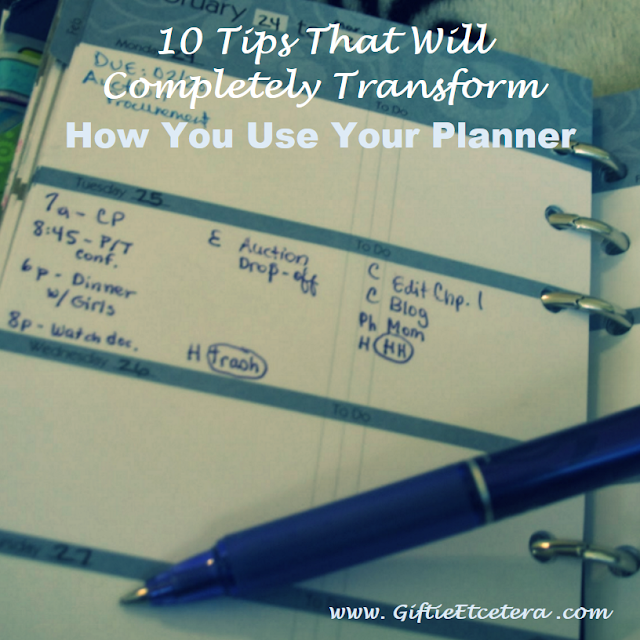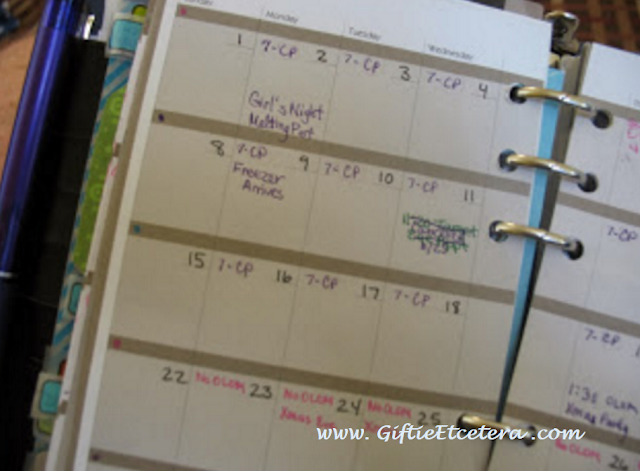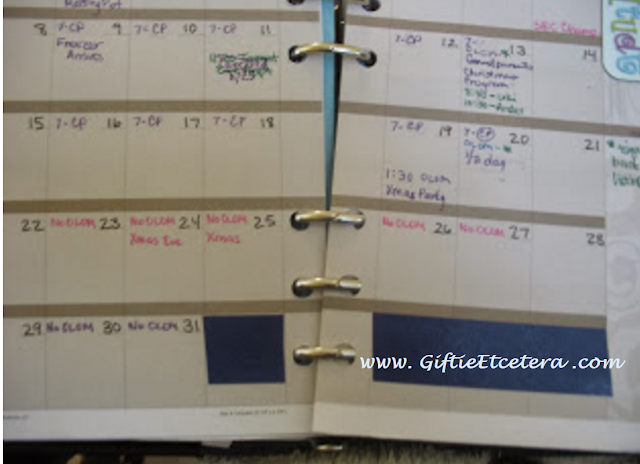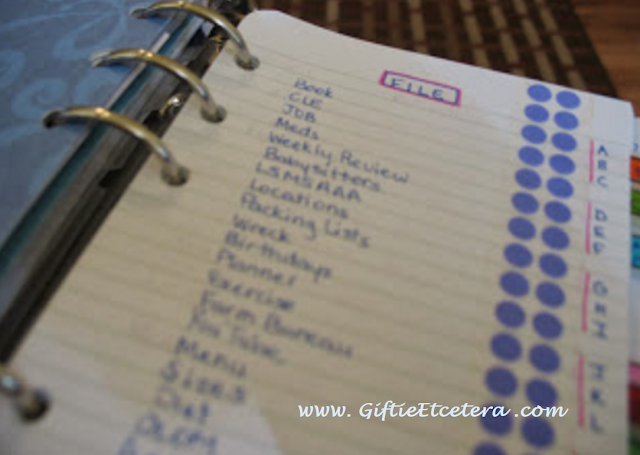1. Keep all appointments in ONE dedicated place.
For me, appointments go on monthlies and everything else goes on weeklies.
But if you need to see everything on one page, dedicate a space on your weekly or daily pages for appointments.
Just don't use two places because you are a mere human and will likely mess up.
For example, in the first picture, I made the first column appointments.
Exception: If you need to put things on a group calendar (for work or family), go ahead and copy things to that calendar, either each time you enter the information or as a daily or weekly task. That said, still write in your planner first every single time so that you know that you can rely on your planner.
TIP: As you write something on the group calendar, have a special code to show that you copied it, like a dot.
2. Use codes.
That way, you will have more space in your planner for writing.
I use CP for carpool, for example.
In the weekly example in the first picture, I use a for am and p for pm. Every bit of saved space counts!
3. Use contexts for tasks.
I use A for anywhere, E for errands, C for computer, and Ph for phone.
Despite my out-of-date picture above, I use P for projects.
4. When you cancel something, make a note over the original entry.
I use A for anywhere, E for errands, C for computer, and Ph for phone.
Despite my out-of-date picture above, I use P for projects.
4. When you cancel something, make a note over the original entry.
In the second picture in this blog entry, on the 11th, I cancelled an eye doctor appointment. I wrote that right over the original appointment, along with the date that I cancelled the appointment. If the doctor tries to charge me for the missed appointment, I have a record to dispute the charges.
5. Use your highlighter color for FYIs.
In the second picture, I use pink to write non-school days.
I don't have to do anything or go anywhere because there is not school, but I need to be aware that the kids will be home for Christmas vacation.
6. Write DUE dates in advance of the due date.
I've discussed this a lot in the past, but you will notice in the second picture that auction solicitation is due on the 28th, but I wrote the due date on the 25th (along with a note of the actual due date). The reason for that is because I need from the 25th to 28th to complete the entire process, so I can't wait any later to be reminded.
7. Circle tasks or appointments that repeat.
In one of the pictures, I circled the word trash. That is because once the trash is put on the curb, I need to rewrite the repeating tasks next week on Tuesday. The circle means to recopy the entry each time I complete it.
In the second picture, I use pink to write non-school days.
I don't have to do anything or go anywhere because there is not school, but I need to be aware that the kids will be home for Christmas vacation.
6. Write DUE dates in advance of the due date.
I've discussed this a lot in the past, but you will notice in the second picture that auction solicitation is due on the 28th, but I wrote the due date on the 25th (along with a note of the actual due date). The reason for that is because I need from the 25th to 28th to complete the entire process, so I can't wait any later to be reminded.
7. Circle tasks or appointments that repeat.
In one of the pictures, I circled the word trash. That is because once the trash is put on the curb, I need to rewrite the repeating tasks next week on Tuesday. The circle means to recopy the entry each time I complete it.
8. Use action verbs for tasks.
For example, I said "Edit Chap. 1" in the first picture. If you know which action to do, it's easier to get started.
I don't need to say "call Mom" next to Ph (phone) because the context (phone) provides the action.
TIP: When writing an action, give yourself a reasonable completion goal. "Edit Chap. 1" or "edit for 30 minutes" is attainable, while "edit novel" is not.
9. Put more important and priority tasks in a separate list from want-to-dos.
You can see an example of this in the weekly spread above, where the priority stuff goes in the second column and the goals go in the third column.
10. Block out the empty days on monthly calendars.
I do this in picture three with washi tape. It keeps me from accidentally writing something on November 31st (which does not exist) instead of December 1st.
If you often think in terms of "the party is next week, on Sunday," this tip is especially important for you.
Whatever you do, always write enough detail.
Enough detail means that the party host's phone number and address and a reminder to bring some wine is there (assuming you don't know the phone number and address by heart), but not the details of who will attend, since you don't need to know that. Saving space is important, but it is not more important than recording enough information.
For example, I said "Edit Chap. 1" in the first picture. If you know which action to do, it's easier to get started.
I don't need to say "call Mom" next to Ph (phone) because the context (phone) provides the action.
TIP: When writing an action, give yourself a reasonable completion goal. "Edit Chap. 1" or "edit for 30 minutes" is attainable, while "edit novel" is not.
9. Put more important and priority tasks in a separate list from want-to-dos.
You can see an example of this in the weekly spread above, where the priority stuff goes in the second column and the goals go in the third column.
10. Block out the empty days on monthly calendars.
I do this in picture three with washi tape. It keeps me from accidentally writing something on November 31st (which does not exist) instead of December 1st.
If you often think in terms of "the party is next week, on Sunday," this tip is especially important for you.
Whatever you do, always write enough detail.
Enough detail means that the party host's phone number and address and a reminder to bring some wine is there (assuming you don't know the phone number and address by heart), but not the details of who will attend, since you don't need to know that. Saving space is important, but it is not more important than recording enough information.
Loyal Readers will recognize many of these, but I thought putting them together in one post would be helpful. It's nothing new, and nothing different, but a great list of details that will make your planner more useful.
Bonus Flashback: Don't forget to review the Christmas Plan that I posted last month if haven't started planning in earnest yet. The video may not be safe for little ears due to discussions of Santa, so use earbuds. ;)
Bonus Flashback: Don't forget to review the Christmas Plan that I posted last month if haven't started planning in earnest yet. The video may not be safe for little ears due to discussions of Santa, so use earbuds. ;)





1 comment:
I know this is an oldie and I have been following your blog and Facebook page for months. I just wanted to say the best tip I have learned from you is to circle repeating tasks. It's such a simple thing to do, but so effective.
Post a Comment